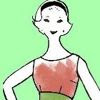Monday, August 29, 2011
Fashion Plates from the McCall Company - 1901 - Afternoon Toilettes and Street Costumes
Take note of the way pleats and lace are used on the skirts, and the variety of collars. And while you are considering the serious underwear these women had to have on to get that silhouette, don't forget about how straight you'd have to stand to hold up those hats!
Sunday, August 28, 2011
Hand Colored Engraved Fashion Plate - Party Ladies!
Thursday, August 25, 2011
Hand Colored Engraving of Ladies Hats
Wednesday, August 24, 2011
Modes de Paris - 1860 Hand-Colored Engraving
"Modes de Paris Petit Paris Boulesart Letters to the ladies of Italy, a
Modes and Mrs. Bricard Calmann, Virginia Vasseur Trimmings Dresses
Lace was the thought of Violard. Fabrics of three quarters of Mrs. Clemencon Corsets, Perfumes of Laboullee. Byoux in hair Fluri to Lemonnier Cilman Fans of Duvelleroy"
Monday, August 22, 2011
Styles for Any Season - 1959
Sunday, August 21, 2011
Simplified Systems of Sewing and Styling - 1948 - Lesson 10 - Accessories, Their Importance and How To Plan Them
Saturday, August 20, 2011
Simplified Systems of Sewing and Styling - 1948 - Lesson 9 - Professional Finishing Details
Friday, August 19, 2011
Simplified Systems of Sewing and Styling - 1948 - Lesson 8 Finishing Coats & Suits, Linings
"...be pieced with sections in the manner described in the paragraph on "Piecing Fur". Fur that is in good condition on the outside but that tears easily because of a tender pelt may be reinforced with cambric. Remove the interlining from the pelt and place the cambric next to the pelt. Quilt the cambric to the pelt, taking stitches 1/2-inch long on the cambric side and catching a very tiny stitch in the pelt. The stitches into the pelt must not catch any of the hair. Do not pull the stitches tight. The entire fur may be reinforced in this way or just the necessary sections may be reinforced. Fig. 24 (1).
Fur may also be quickly reinforced by cementing the cotton cambric. This method is practical only if the pelt is too tender to hold the quilting stitches. Choose a rubber cement or other adhesive such as milliners' glue that does not require heat. With a brush or spatula, spread the cement evenly over the pelt, then apply the cambric. The cambric will in this way adhere to the pelt and stitching is unnecessary. Fig. 24 (J). Finish the fur with interlining and tape as explained before.
Fur Cloth: Good imitations of fur may be purchased by the yard as fur cloth. However, fur cloth should not be confused with fur in construction, for it is treated as a fabric.
In cutting remember that the nap should run down toward the bottom of the garment.
If the fabric has a thick, heavy nap use a long stitch in sewing on the machine. Press all seams over a velvet board. If one is not accessible the seams may be pressed lightly on the wrong side and then steamed as for velvets.
Fur cloth will enhance the beauty of a garment if a good quality is purchased and if the precautions given for cutting and construction are followed closely."
Thursday, August 18, 2011
Simplified Systems of Sewing and Styling - 1948 - Lesson 7 - Sleeve Finishes - Hems and Setting in Sleeves
So much to know, but oh so important to get these details right!

